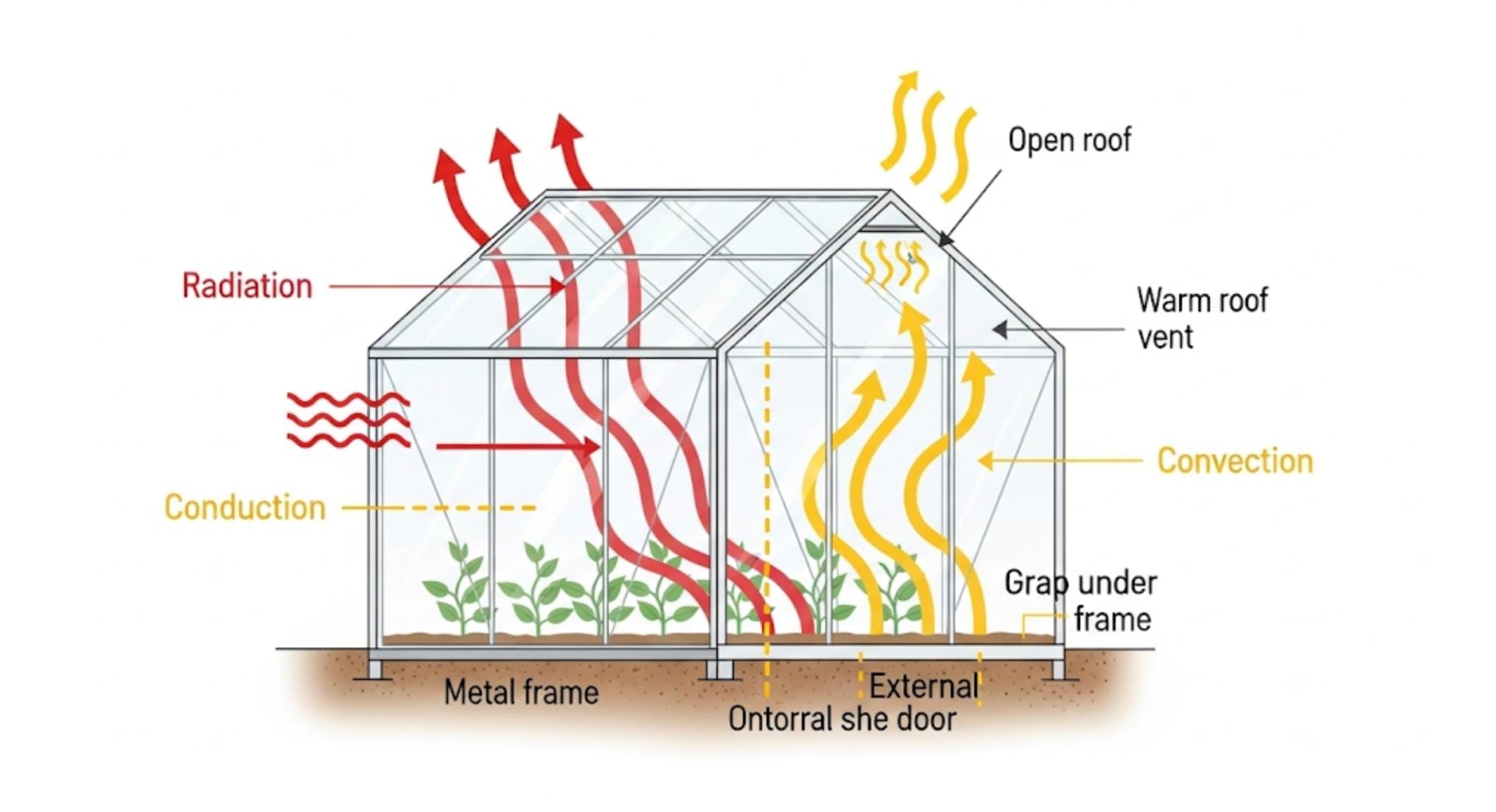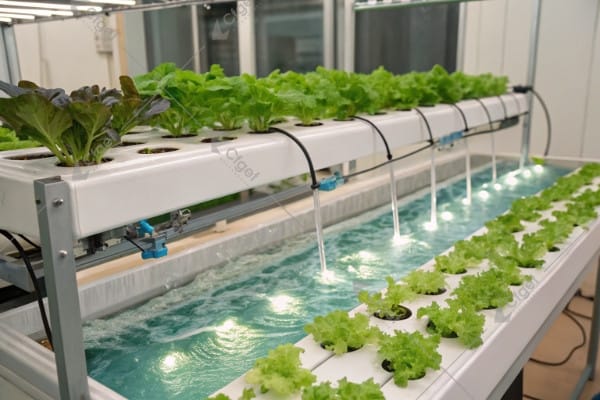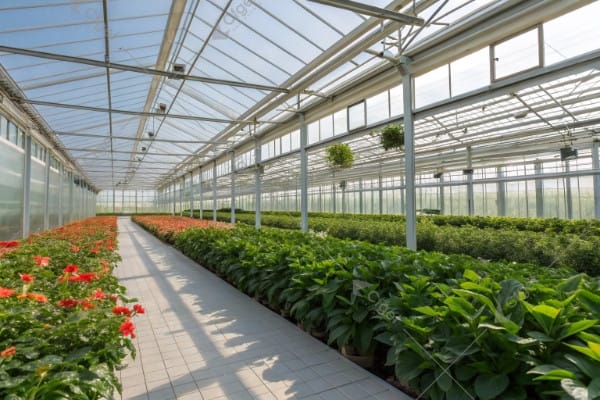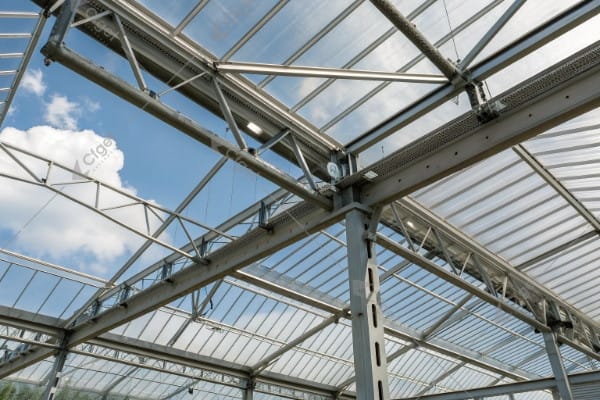Choosing the right greenhouse covering feels complex, right? A poor choice can hurt your yields and increase long-term costs. Glass, however, offers some distinct advantages worth exploring.
Glass greenhouses stand out as premium structures. They provide excellent light transmission and are very durable. This makes them a top choice for serious commercial farming, research, and achieving precise climate control.
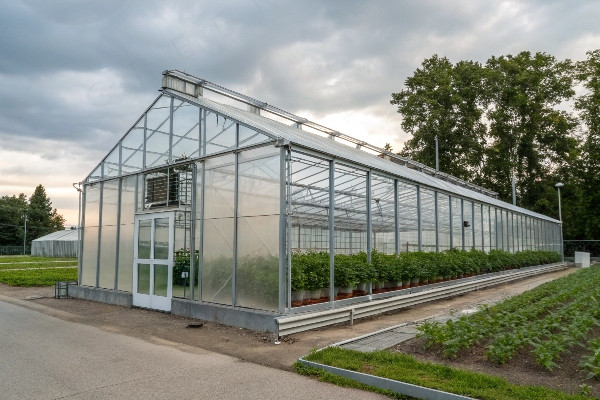
Now, let’s look closer at why glass might, or might not, be the perfect fit for your specific needs. We need to understand the different kinds available, how they compare to other materials, and how glass impacts the all-important factor: plant growth. Making the right choice involves weighing several factors, which we’ll explore together. As someone who’s been in the greenhouse business with CFGET for over 28 years, I’ve seen firsthand how crucial this decision is.
Don’t Miss:—— 12 Common Greenhouse Types
You might be interested in:——Is Commercial Greenhouse Farming Really A Profitable Business Opportunity?
What Types of Glass Are Used in Greenhouses?
Feeling puzzled by all the glass options for greenhouses? Using the wrong type can impact everything from plant growth to your heating bills. Making a smart choice from the start is essential.
Greenhouses commonly use annealed (standard float) glass, tempered (safety) glass, laminated glass, low-iron glass for maximum light, or coated glass like diffused or Low-E options. Each type has unique benefits for light, safety, and insulation.
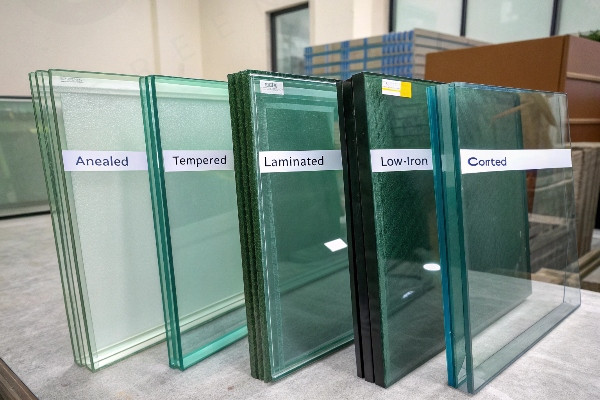
Understanding the nuances between these glass types is fundamental to designing or choosing a greenhouse that performs optimally for your specific situation. Let’s break down the most common options you’ll encounter.
Annealed Glass (Float Glass): This is the basic, standard flat glass produced using the float glass process. It’s the most common type of glass found in older or less expensive greenhouse structures. While it offers good initial light transmission, its primary drawback is safety. When it breaks, it shatters into large, sharp shards, posing a significant risk. For this reason, its use in overhead glazing or areas with high human traffic is often restricted by building codes. Its structural strength is also lower compared to treated glass types. We generally recommend considering safer alternatives, especially for commercial or research applications where safety and durability are paramount.
Tempered Glass: This is annealed glass that has undergone a special heat treatment process (heating and rapid cooling). This process increases its strength significantly – about four to five times stronger than annealed glass of the same thickness. The major advantage of tempered glass is its safety break pattern. When it breaks, it crumbles into small, relatively harmless granular pieces rather than sharp shards. This makes it a much safer option for greenhouse roofs and walls. Due to its strength, it can also handle higher wind and snow loads. Most modern, high-quality glass greenhouses, like those we design at CFGET, utilize tempered glass, particularly for roofing and potentially sidewalls depending on the application and budget. [Placeholder for personal story: I remember visiting a client in a region prone to hailstorms. Their old annealed glass greenhouse suffered significant damage, but a nearby structure we had supplied using tempered glass came through virtually unscathed. It highlighted the value of that extra strength and safety.]
Laminated Glass: This type consists of two or more layers of glass bonded together with a plastic interlayer, typically polyvinyl butyral (PVB) or ethylene-vinyl acetate (EVA). When laminated glass breaks, the fragments tend to stick to the interlayer, rather than shattering outward. This provides a high level of safety and security. It also offers slightly better sound insulation and can block nearly 99% of UV radiation, which can be beneficial or detrimental depending on the crop and whether beneficial insects requiring UV cues are used. Laminated glass is heavier and more expensive than tempered glass, so its use in greenhouses is often limited to specific areas where maximum safety or UV blockage is critical, such as research facilities or public-facing areas like botanical gardens.
Low-Iron Glass: Standard clear glass has a slight greenish tint due to the iron oxide content from the manufacturing process. This tint reduces light transmission, especially noticeable in thicker panes. Low-iron glass is manufactured using raw materials with very low iron content, resulting in a clearer glass with significantly higher light transmission – often boosting PAR (Photosynthetically Active Radiation) light by several percentage points compared to standard glass. For growers of high-light crops or those in regions with lower natural light levels, this extra light can directly translate to faster growth and higher yields. While more expensive than standard tempered glass, the potential return on investment through increased production often justifies the cost for high-value crops. We often specify low-iron glass for clients in Northern Europe or for research applications demanding maximum light levels.
Coated Glass (Diffused, Low-E):
- Diffused Glass: This glass has a pattern or coating applied that scatters the incoming sunlight. Instead of direct beams, the light is spread more evenly throughout the greenhouse, reducing harsh shadows and minimizing the risk of sun scorch on upper leaves. Diffused light penetrates deeper into the plant canopy, potentially increasing overall photosynthesis. This is particularly beneficial for dense canopy crops like tomatoes, cucumbers, or leafy greens. The diffusion level can vary.
- Low-E (Low Emissivity) Glass: This glass has a microscopically thin, transparent coating that reflects thermal radiation (heat). In winter, it helps keep heat inside the greenhouse, reducing heating costs. In summer, it can help reflect some external heat radiation, although its primary benefit is in retaining internal heat. Low-E coatings slightly reduce visible light transmission, so there’s a trade-off between energy savings and maximum light levels. It’s often used in double-glazing units for maximum insulation.
Here’s a simple table summarizing key differences:
| Glass Type | Key Feature | Strength | Safety Break Pattern | Light Transmission | UV Blockage | Relative Cost | Typical Use |
|---|---|---|---|---|---|---|---|
| Annealed (Float) | Basic, untreated | Standard | Large shards | Good | Low | Low | Older/basic structures (less common now) |
| Tempered | Heat-treated strength & safety | High (4-5x) | Small granules | Good | Low | Medium | Roofs, Walls (Standard modern) |
| Laminated | Interlayer bonding | High | Holds fragments | Slightly Lower | Very High | High | High safety/security needs, UV block |
| Low-Iron | High clarity, max light | High (if tempered) | Varies (depends on base) | Excellent | Low | High | High-light crops, low-light regions |
| Diffused | Scatters light, reduces shadows | High (if tempered) | Varies (depends on base) | Good (but scattered) | Low | Medium-High | Dense canopies, reduces scorch |
| Low-E | Reduces heat transfer | High (if tempered) | Varies (depends on base) | Slightly Lower | Low | Medium-High | Energy efficiency, colder climates |
Choosing the right type involves balancing your budget, crop requirements, local climate, and safety regulations. At CFGET, we work closely with clients, drawing on our experience across diverse global environments – from the humid tropics of Southeast Asia to the variable climates of Europe and the extreme conditions in Central Asia – to recommend the glass specification that delivers the best value and performance.
Glass vs. Alternatives: What Are the Real Pros and Cons for Your Greenhouse?
Comparing glass with polycarbonate or poly film for your greenhouse? This choice significantly affects durability, costs, and ultimately, your plants’ growth environment. Let’s clarify the trade-offs.
Glass offers unmatched longevity, stable light quality, and aesthetic appeal but has a higher initial cost and structural weight. Alternatives like polycarbonate provide better insulation and impact resistance but degrade over time, reducing light transmission.
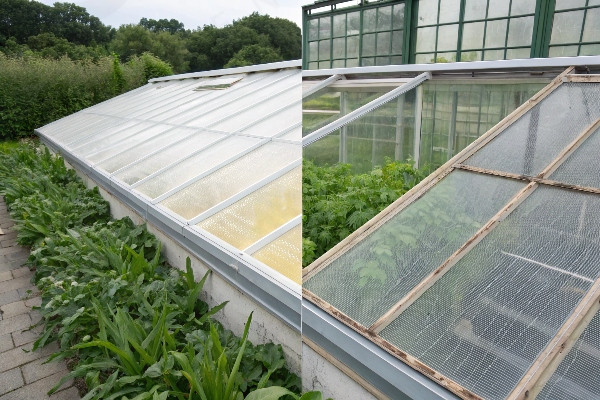
Deciding on the best glazing material is one of the most critical decisions in greenhouse construction. It impacts not just the initial build but the long-term operational efficiency and success of your growing operation. Let’s compare glass head-to-head with the most common alternatives: polycarbonate panels and polyethylene film.
1. Light Transmission (Quality, Quantity, Longevity):
- Glass: Offers the highest initial light transmission, especially low-iron glass (often 90%+ PAR). Crucially, glass does not significantly degrade or yellow over time due to UV exposure, meaning this high light transmission remains stable for decades. It transmits light directly without much diffusion unless specifically treated (diffused glass).
- Polycarbonate (Twin-wall/Multi-wall): Initial light transmission is good (typically 80-85% for twin-wall), but it degrades over time due to UV exposure. Even UV-protected panels will gradually yellow and become more brittle, reducing light transmission noticeably within 5-10 years, sometimes sooner in high-UV environments. It naturally diffuses light more than clear glass.
- Polycarbonate (Solid/Clear): Offers light transmission closer to glass initially but is much more expensive than twin-wall and still prone to UV degradation and scratching, which reduces clarity over time.
- Polyethylene Film (PE Film): Offers good initial light transmission (often 85-90%+ for single layer, high-quality film). However, PE film degrades relatively quickly under UV light and needs replacement every 3-6 years depending on quality, additives (UV inhibitors, anti-drip), and climate. Light transmission drops as the film ages and gets dirty or hazy. Double-layer inflated systems reduce transmission slightly due to the two layers.
2. Durability and Longevity:
- Glass: Extremely durable against weathering and UV. Tempered glass is resistant to scratching and chemical damage. Its lifespan can easily exceed 30-40 years if structurally sound and not broken by impact. It’s susceptible to impact breakage (hail, stones) unless laminated.
- Polycarbonate: More impact-resistant than standard glass (less so than laminated glass). However, it scratches easily, reducing light transmission and aesthetics. Its lifespan is limited by UV degradation, typically warrantied for 10 years, but practical replacement cycles are often 7-15 years.
- PE Film: Least durable. Prone to tears, punctures, and rapid UV degradation. Requires regular replacement every few years, representing an ongoing maintenance cost and labor effort.
3. Insulation (R-value):
- Glass: Single-pane glass has poor insulation (R-value ~0.9). Double-pane glass units significantly improve this (R-value ~2.0), and Low-E coatings can push it higher. However, double-glazing adds significant cost and weight.
- Polycarbonate (Twin-wall/Multi-wall): Offers better insulation than single glass due to the air channels. Typical R-values range from 1.4 (4mm twin-wall) to 3.0+ (thicker multi-wall panels). This is a major advantage in colder climates, reducing heating costs.
- PE Film: Single layer offers very little insulation (similar to single glass). Double-layer inflated systems create an insulating air gap, significantly improving the R-value (typically 1.5-1.7), making it a cost-effective way to improve energy efficiency compared to single glass or film.
4. Weight and Structural Requirements:
- Glass: Heaviest option. Requires a strong, robust supporting structure (steel or aluminum frame), increasing the overall construction cost. Foundation requirements are also more substantial.
- Polycarbonate: Significantly lighter than glass. Allows for lighter, potentially less expensive support structures compared to glass.
- PE Film: Lightest option by far. Can be used on simple, inexpensive structures like hoop houses.
5. Impact Resistance:
- Glass: Annealed glass is fragile. Tempered glass is much stronger but can still break from sharp impacts. Laminated glass offers the best impact resistance among glass types. Hail can be a significant risk for glass roofs.
- Polycarbonate: Excellent impact resistance, often described as "virtually unbreakable" in marketing, although it can be dented or punctured by severe impacts. Far superior to standard glass in this regard.
- PE Film: Susceptible to punctures and tears from sharp objects, wind-driven debris, or heavy snow loads if not properly supported.
6. Maintenance:
- Glass: Relatively easy to clean. Resistant to most chemicals. Does not degrade or need replacement unless broken. Can be prone to algae growth in joints or on surfaces if not kept clean.
- Polycarbonate: Scratches easily during cleaning. Requires specific cleaning agents to avoid chemical damage. Surface treatments (like anti-drip) can wear off. Needs eventual replacement due to degradation.
- PE Film: Difficult to clean effectively. Prone to dust and dirt build-up. Requires periodic re-tensioning and eventual replacement.
7. Cost (Initial vs. Lifetime):
- Glass: Highest initial material and structural cost. However, its long lifespan and stable light transmission mean lower replacement costs and potentially higher long-term yields, making the lifetime cost potentially competitive, especially for high-value production.
- Polycarbonate: Moderate initial cost (more than film, less than glass). Replacement costs every 10-15 years need to be factored into the lifetime cost. Energy savings can offset some costs compared to single glass.
- PE Film: Lowest initial material and structural cost. However, frequent replacement (every 3-6 years) results in significant ongoing material and labor costs over the lifespan of the greenhouse.
Here’s a comparison table:
| Feature | Glass | Polycarbonate (Twin-Wall) | Polyethylene Film (Double Inflated) |
|---|---|---|---|
| Light (Initial) | Excellent (esp. Low-Iron) | Good | Very Good |
| Light (Long-Term) | Stable, No Degradation | Degrades (Yellows) | Degrades (Needs Replacement) |
| Longevity | Very High (30+ years) | Medium (10-15 years) | Low (3-6 years) |
| Insulation | Poor (Single), Good (Double) | Good to Very Good | Good (if double inflated) |
| Weight | Heavy | Light | Very Light |
| Impact Resist. | Poor (Annealed), Good (Tempered) | Excellent | Poor (Tears/Punctures) |
| Maintenance | Low (Cleaning) | Medium (Careful Cleaning, Replace) | High (Replace Frequently) |
| Initial Cost | High | Medium | Low |
| Lifetime Cost | Medium-High (depends on breakage) | Medium-High (includes replacement) | Medium (includes frequent replacement) |
| Aesthetics | Excellent | Good | Basic |
[Placeholder for personal story: We worked with a research institute that initially used polycarbonate for cost savings. However, they found the decreasing light transmission after just 5 years was impacting the consistency of their experiments. They ultimately decided to reclad critical sections with low-iron tempered glass, accepting the higher upfront cost for the long-term light stability required for reliable research outcomes. It showed how ‘cheaper’ isn’t always less expensive in the long run.]
At CFGET, we help clients navigate these trade-offs based on their specific context. For a large-scale flower grower in the Netherlands focused on aesthetics and maximum stable light, glass is often the clear choice. For a vegetable grower in Central Asia facing extreme temperatures and potential hail, the balance might shift towards polycarbonate for insulation and impact resistance, or perhaps a robust glass structure if the budget allows and heating costs are manageable. For seasonal growers or those on tight budgets, PE film remains a viable starting point. The key is aligning the material properties with the climate, crop, budget, and long-term goals.
How Does Glass Truly Affect Light and Plant Growth in a Greenhouse?
Are you concerned that glass might block the essential light your plants need? Understanding exactly how glass interacts with sunlight is crucial for optimizing growth. Don’t let misconceptions limit your greenhouse’s potential.
Glass typically provides high and consistent transmission of Photosynthetically Active Radiation (PAR). Specific types like low-iron glass maximize light entry, while diffused glass scatters light, improving canopy penetration and reducing shadows for potentially better overall growth.
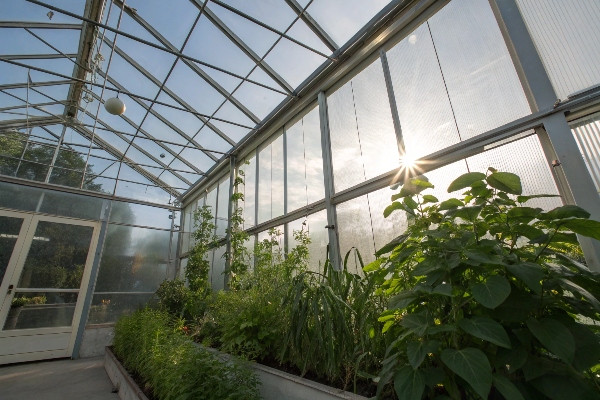
Light is arguably the most critical environmental factor for plant growth inside a greenhouse. The glazing material acts as the gatekeeper for this vital resource. Glass, in its various forms, interacts with sunlight in specific ways that directly influence the quantity, quality, and distribution of light reaching the plants.
Understanding PAR Light: Plants primarily use light in the 400-700 nanometer wavelength range for photosynthesis. This is known as Photosynthetically Active Radiation (PAR). The main goal of a greenhouse covering is to transmit as much PAR light as possible, consistently over time.
Quantity of Light Transmission:
- Standard Clear Glass: Transmits a high percentage of incident PAR light, typically around 88-90% for a single pane of standard 4mm tempered glass.
- Low-Iron Glass: As mentioned earlier, this specialized glass minimizes the iron content, reducing the slight green tint and boosting PAR transmission to 91-92% or even slightly higher. This seemingly small percentage increase can be significant over the course of a growing season, especially for high-light demanding crops like tomatoes, peppers, roses, or cannabis, or in regions with limited natural sunlight. More light generally equates to more potential photosynthesis and thus, faster growth and higher yields, assuming other factors like CO2, water, and nutrients are not limiting.
- Double Glazing/Coatings: Adding a second pane of glass (double glazing) will slightly reduce overall light transmission compared to a single pane, simply due to reflection and absorption by the additional layer. Low-E coatings also cause a minor reduction in visible light transmission. This trade-off between energy conservation and maximum light must be carefully considered.
Quality and Distribution of Light:
- Direct vs. Diffused Light: Standard clear glass allows sunlight to pass through directly, creating sharp contrasts between brightly lit areas and shaded areas within the plant canopy. Upper leaves can receive very high light intensity, sometimes leading to photoinhibition (light stress) or scorching, while lower leaves remain heavily shaded, limiting their photosynthetic contribution.
- Diffused Glass: Glass with a surface treatment or pattern (like matte or prismatic finishes) scatters the incoming light. This diffused light penetrates deeper into the plant canopy, illuminating lower leaves more effectively and creating a more uniform light environment throughout the greenhouse. This can lead to several benefits:
- Reduced risk of scorching on top leaves.
- Increased light availability for lower leaves, potentially boosting overall canopy photosynthesis.
- Softer light quality, which can be beneficial for shade-tolerant plants or during propagation.
- Studies have shown yield increases in certain crops (e.g., tomatoes, cucumbers, peppers, leafy greens) under diffused light compared to direct light, especially in high-light conditions.
- However, diffusion always comes with a slight reduction in total light transmission compared to the equivalent clear glass. The optimal level of diffusion (often measured by a "Haze" factor) depends on the crop, climate, and growing strategy. [Placeholder for personal story: I recall a lettuce grower client who switched the roof of their greenhouse to diffused glass. They reported more uniform growth across their NFT channels and fewer instances of tip burn on sunny days, attributing it to the scattered light.]
UV Transmission:
- Standard float glass naturally blocks a significant portion of UVB radiation but transmits some UVA.
- Some plastics like polycarbonate often have UV-blocking additives.
- Whether UV transmission is beneficial or detrimental is complex and depends on the specific crop and situation. UV light can:
- Inhibit elongation (leading to more compact plants).
- Increase leaf thickness and pigmentation (anthocyanins, antioxidants).
- Potentially suppress certain fungal diseases.
- Be necessary for the orientation of some pollinators like bees.
- Degrade plastics and other materials within the greenhouse faster.
- Special UV-transmitting glass (or films) are available if maximizing UV exposure is desired, though standard greenhouse glass typically has low UV transmission compared to being outdoors. Laminated glass blocks almost all UV.
Long-Term Stability: A key advantage of glass is its stability. Unlike plastics that degrade, yellow, and lose transmission properties over time, glass maintains its initial light transmission characteristics for decades. This provides a consistent growing environment year after year, which is particularly important for long-term commercial operations and research facilities where predictable performance is crucial.
At CFGET, we understand that optimizing light is key. We don’t just supply glass; we consider the specific light requirements of your crops and your local climate conditions (average light levels, typical angles of incidence) to recommend the best glass type – whether it’s maximizing every photon with low-iron glass, creating uniform light with diffused glass, or balancing light with energy efficiency using coated or double-glazed options. We can even incorporate supplemental lighting designs that work synergistically with the chosen glazing.
What Key Factors Must You Consider When Selecting Greenhouse Glass?
Ready to invest in a glass greenhouse but unsure which specific glass to choose? Overlooking critical factors during selection can lead to inefficiency or unexpected costs later. Let’s ensure you make an informed decision.
Key factors include your budget (initial vs. lifetime), local climate (insulation needs, snow/wind loads), specific crop light requirements, desired longevity and maintenance levels, safety regulations, and structural compatibility. Expert advice helps optimize this choice.
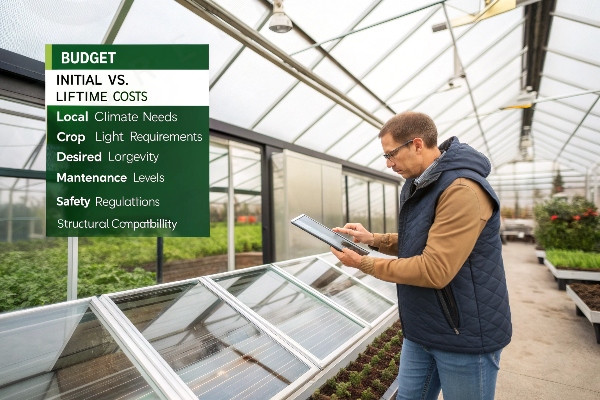
Selecting the right glass for your greenhouse isn’t just about picking a material; it’s about specifying the type of glass and configuration that best suits your unique circumstances. It’s a decision with long-term implications for cost, productivity, and safety. Here’s a breakdown of the critical factors I always discuss with clients:
1. Budget: Glass greenhouses represent a significant upfront investment compared to poly film or polycarbonate structures. Within glass options, costs vary: annealed is cheapest (but often not recommended for safety), standard tempered is mid-range, while low-iron, laminated, diffused, and double-glazed units increase the cost progressively. Consider not just the initial material cost but also the potentially higher cost of the required supporting structure due to the weight of glass. Balance this against the long-term benefits: longevity (minimal replacement cost), stable light transmission (consistent yield potential), and potential energy savings (with double glazing/Low-E). It’s about lifetime value, not just the initial price tag.
- Temperature: In cold climates, insulation is crucial to manage heating costs. Single-pane glass offers poor insulation. Double glazing, possibly with Low-E coatings, becomes highly advantageous, despite the higher cost and slight light reduction. In hot climates, ventilation is key, but features like exterior shading or even heat-reflecting coatings might be considered, though often ventilation and active cooling are more primary strategies. Diffused glass can also help mitigate heat stress on plants.
- Light Levels: In regions with low natural light (e.g., Northern Europe, cloudy climates), maximizing light transmission with low-iron glass can be critical for year-round production. In very high light regions, standard or even slightly tinted glass might suffice, or diffused glass could be prioritized to prevent scorching.
- Wind and Snow Loads: Glass panels, especially large ones on roofs, must withstand local wind pressures and potential snow accumulation. Thicker glass or smaller pane sizes might be required, increasing cost and potentially reducing light slightly (due to more framing). Tempered glass offers greater strength than annealed glass. Engineering calculations based on local building codes are essential. We at CFGET always ensure our structures are designed to meet or exceed local load requirements, crucial for clients in Central Asia facing heavy snow or coastal areas with high winds.
3. Crop Requirements: Different plants have different needs.
- Light Intensity: High-light crops (tomatoes, peppers, roses) benefit most from high-transmission glass like low-iron.
- Light Quality: Crops prone to scorching or those with dense canopies (lettuce, cucumbers) may thrive under diffused glass.
- Temperature Sensitivity: Crops needing very stable temperatures might justify the investment in double glazing.
- UV Sensitivity/Requirements: Consider if UV blocking (laminated) or transmission is preferred for your specific crop or IPM strategy (e.g., pollinator needs).
4. Longevity and Maintenance: Glass offers excellent longevity (30+ years) if not broken. Maintenance mainly involves cleaning to maintain light transmission. Consider the risk of breakage (e.g., hail, accidents) and the cost/availability of replacement panes. Polycarbonate requires more careful cleaning and eventual replacement; film requires frequent replacement. If minimizing long-term hassle and replacement cycles is a priority, glass is often favored.
5. Safety and Regulations: Building codes often mandate safety glass (tempered or laminated) for overhead glazing (roofs) and sometimes for walls, especially in commercial or public-access structures. Using annealed glass in inappropriate locations can create significant liability risks and may not be permissible. Always check local regulations. We ensure all CFGET glass greenhouses comply with relevant safety standards.
6. Structural Compatibility: Glass is heavy. The greenhouse frame (whether aluminum or steel) must be engineered to support the specific weight of the chosen glass type and size, along with environmental loads (wind, snow). Retrofitting glass onto a structure designed for lighter poly film or polycarbonate is often not feasible without significant structural upgrades.
7. Supplier Support and Expertise: Choosing the glass is one part; ensuring it’s integrated correctly into a well-designed structure with appropriate ventilation, heating, and other systems is equally important. Working with an experienced supplier like CFGET ensures you get not just the material, but the technical support to make it work optimally. We helpn global experience. We had a project where navigating the specific seismic codes in one region required adjustments to both the frame design and the glass mounting system. Our engineering team worked closely with local authorities to ensure full compliance, something a less experienced supplier might have struggled with.
Here’s a table summarizing these factors:
| Factor | Key Considerations | Glass Implications |
|---|---|---|
| Budget | Initial cost vs. Lifetime value, structural costs | High initial cost, potentially lower lifetime cost (longevity) |
| Climate | Temperature extremes, light levels, wind/snow loads | Insulation (single vs. double/Low-E), Light type (low-iron/diffused), Strength/Thickness |
| Crop | Light needs (intensity/quality), temperature sensitivity, UV requirements | Glass type (low-iron, diffused, standard), coatings, UV transmission properties |
| Longevity | Desired lifespan, tolerance for replacement cycles | Very long lifespan, minimal degradation |
| Maintenance | Cleaning ease, replacement risk/cost | Easy to clean, breakage risk exists |
| Safety | Local building codes, overhead glazing rules, human traffic | Tempered or Laminated glass often required |
| Structure | Weight bearing capacity of frame and foundation | Requires robust, engineered supporting structure |
| Supplier | Experience, technical support, system integration | Crucial for optimal design and performance |
Making the right choice involves carefully weighing these factors against your specific goals and operational context. It’s a decision where expert consultation can provide significant value, ensuring your investment delivers the performance you expect for years to come.
Conclusion
Choosing glass for a greenhouse is a major decision. It offers superior light quality and unmatched durability, making it ideal for serious growers and researchers aiming for precise environmental control and long-term performance.
Exploring climate impacts on greenhouse design helps optimize conditions for plant growth and energy efficiency, crucial for successful cultivation. ↩

